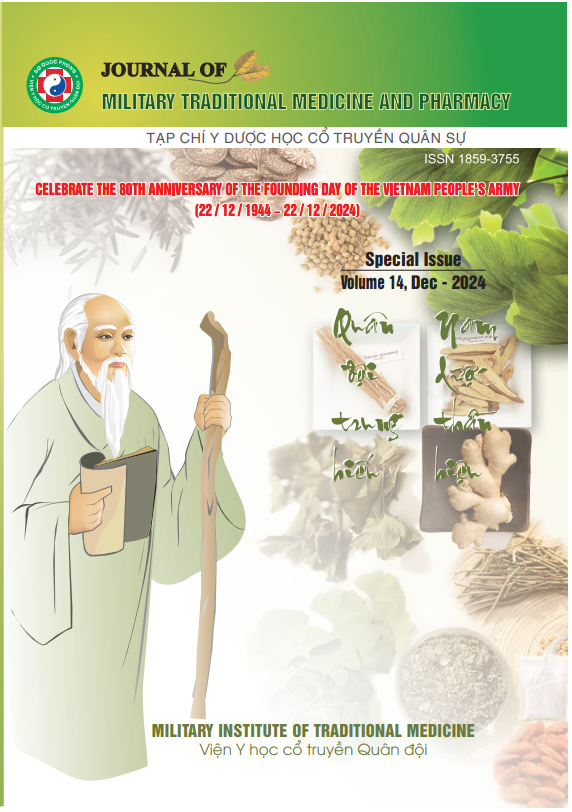BOTANICAL CHARACTERISTICS OF HOANG CAM (Scutellaria baicalensis Georgi) CULTIVATED IN BAC HA, LAO CAI
Nội dung chính của bài viết
Tóm tắt
Hoang cam (Scutellaria baicalensis Georgi), has been used as a medicinal herb for over 2000 years in East Asian countries and is recorded in the Chinese Pharmacopoeia. Our study aimed to comprehensively describe the morphological and anatomical characteristics of Hoang camcultivated in Bac Ha, Lao Cai, contributing to the completion of species identification, reference, and providing data for implementing technical measures to increase the yield of medicinal herbs. The results showed that: Hoang camhas a tuberous root with few branches, young stems with four edges. Leaves are simple, opposite, lanceolate, with pinnate venation. Flowers are solitary, bisexual; corolla is purple, divided into two lips; 4 stamens, triangular anthers, superior ovary. Fruit is a schizocarp, with a persistent calyx. Seeds are oval, black. The root anatomy has a circular cross-section, with many layers of periderm covering the outside, secondary xylem, and abundant stone cells. The stem anatomy has a square cross-section, with convex corners, vascular bundles concentrated at the four convex corners, with sclerenchyma and thick tissue protecting the bundle apex, and abundant pith parenchyma. Leaf anatomy has a hairy epidermis, specialized parenchyma occupying a large area, and small vascular bundles.
Chi tiết bài viết
Từ khóa
Hoàng Cầm
Tài liệu tham khảo
2. Do Thi Xuyen, Ngo Thu Hao, Doan Van Ve, Nguyen Trung Thanh (2022). Anatomical Features of Scutellaria tonkinensis Doan in Vietnam. VNU Journal of Science: Natural Sciences and Technology. 38(4):1-5.
3. Do Huy Bich, Dang Quang Trung, Bui Xuan Chuong, Nguyen Thuong Dong, Do Trung Dam, Pham Van Hien, Vu Ngoc Lo, Pham Duy Mai, Pham Kim Man, Doan Thi Nhu, Nguyen Tap & Tran Toan (2006). Medicinal Plants and Medicinal Animals (Volume 1). Science and Engineering Publishing House. pg. 935-938.
4. Do Thi Lan Huong (2015). Morphological and anatomical characteristics of Scutellaria barbata D. Don, belonging to the mint family (Lamiaceae), cultivated in Vietnam. Proceedings of the 6th National Scientific Conference on Ecology and Biological Resources, pg. 173-178.
5. Nguyen Nghia Thin (2007). Plant research methods. Hanoi National University Publishing House, 171 pages.
6. Phung Thi Thu Ha, Nguyen Huu Cuong, Nguyen Thi Hoa, Tran Binh Da, Pham Phu Long & Pham Thi Huyen Trang (2021). Botany textbook. Publishing House of the Academy of Agriculture. pg. 111-112.
7. Tran Cong Khanh (1981). Textbook on Plant Anatomical Morphology. Hanoi University and Vocational High School Publishing House, 172 pg.
8. Wojtunik-Kulesza, K., Kasprzak-Drozd, K., Sajdlowski, D., Oniszczuk, A., Swiatkowski, W., and Waksmundzka-Hajnos, M. (2021). ScutellariaBaicalensis - A Small Plant with Large Pro-health Biological Activities. Curr.Issues Pharm. Med. Sci. 34, 55–59.
9. Zhao T, Tang H, Xie L, Zheng Y, Ma Z, Sun Q, Li X, (2019). Scutellaria baicalensis Georgi. (Lamiaceae): a review of its traditional uses, botany, phytochemistry, pharmacology and toxicology. J Pharm Pharmacol. 71(9):1353-1369. doi: 10.1111/jphp.13129. Epub 2019 Jun 24. PMID: 31236960


